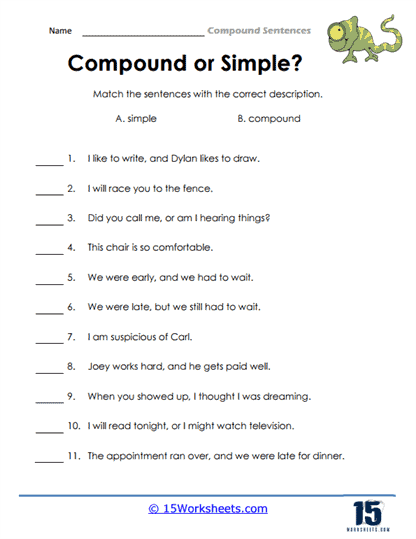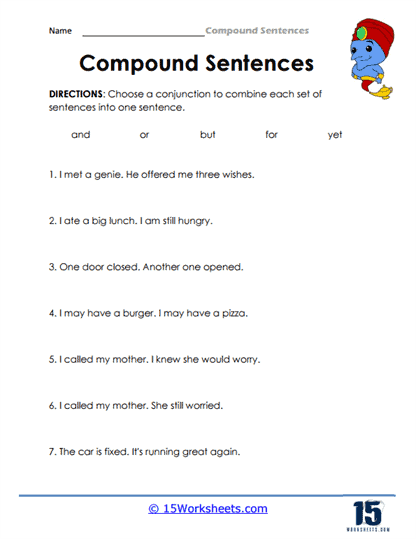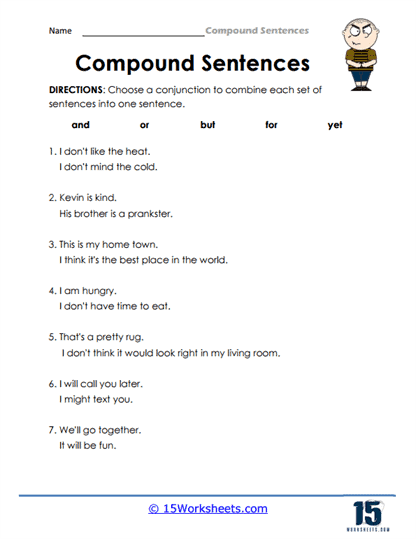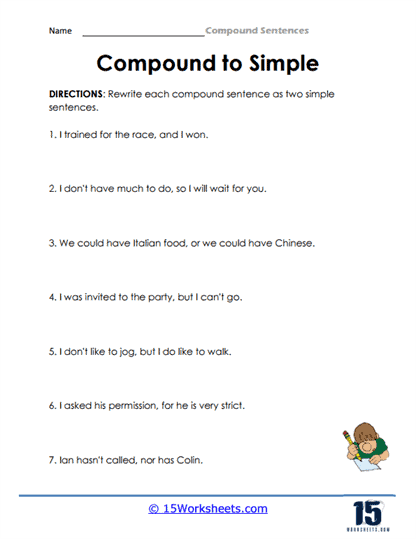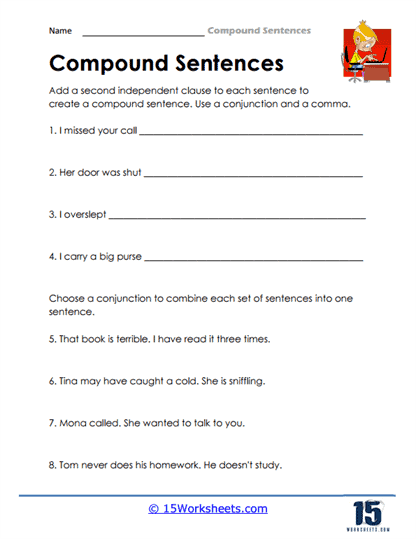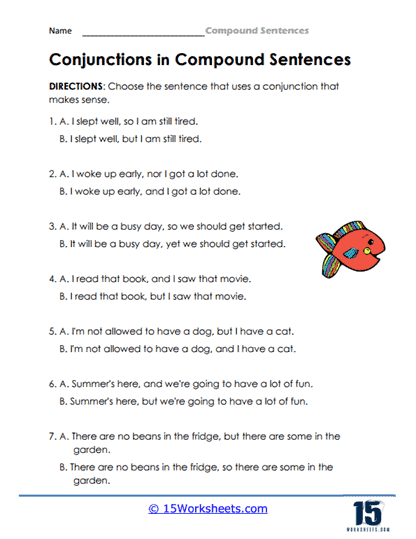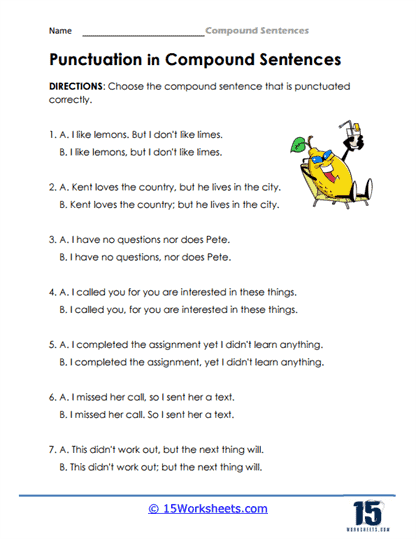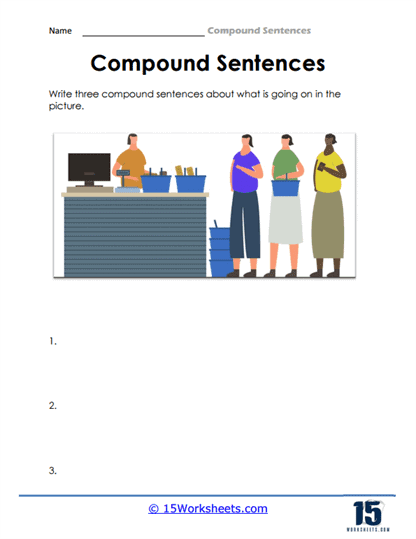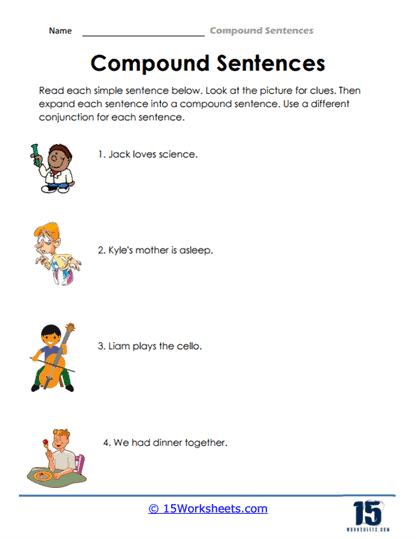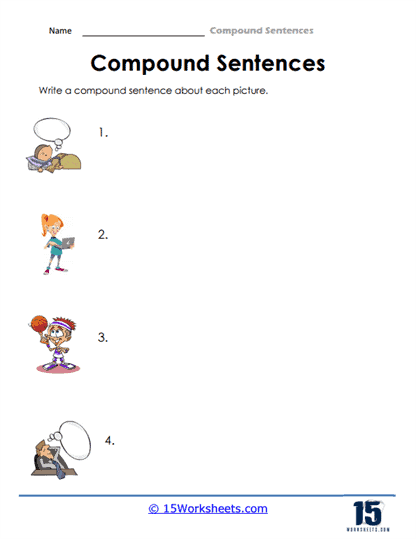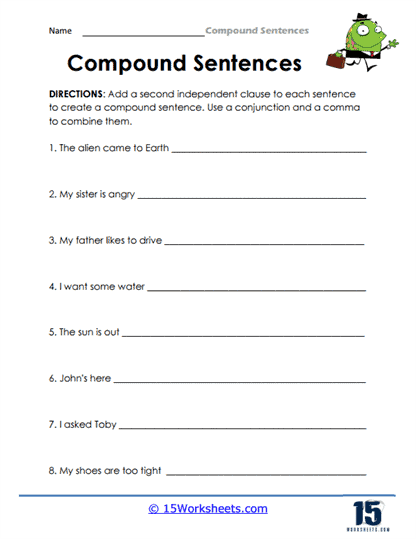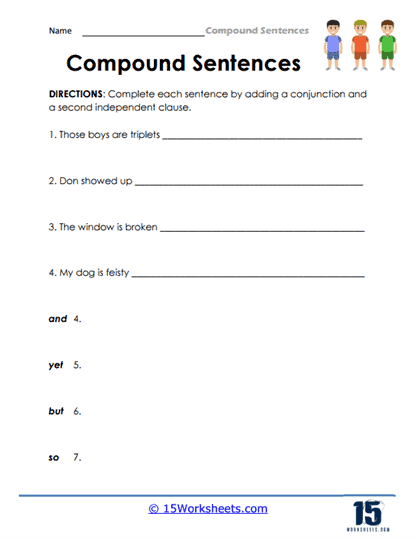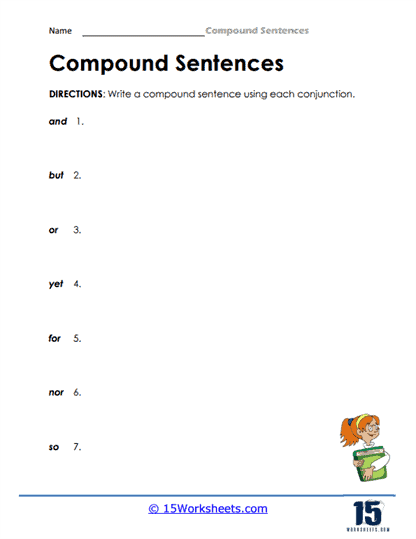Compound Sentences Worksheets
All About These 15 Worksheets
This comprehensive series of 15 worksheets is thoughtfully designed to equip students with the essential skills for constructing and effectively using compound sentences. Each worksheet in the series is carefully structured, featuring guided exercises and interactive activities that progressively enhance students’ understanding of compound sentence structures. The aim is to provide clear, step-by-step support, enabling students to not only grasp the mechanics of these sentences but also apply them confidently in their writing.
The worksheets are tailored to meet the needs of students at various grade levels, ensuring that learners with different abilities can benefit from the exercises. With a focus on the critical components of sentence structure, each worksheet introduces students to a range of tasks that highlight key aspects of compound sentences. These include distinguishing simple sentences from compound ones, combining independent clauses using coordinating conjunctions, and transforming compound sentences back into simple sentences to reinforce their understanding of the sentence forms. By offering diverse and incremental challenges, the worksheets guide students through a process that deepens their comprehension while encouraging active learning.
Throughout this series, students will engage with multiple activities designed to build mastery. They will start by identifying the differences between simple and compound sentences, sharpening their ability to recognize the structural components that distinguish one from the other. Next, they will practice combining pairs of simple sentences to form compound ones, using coordinating conjunctions such as “and,” “but,” or “so.” This practice not only reinforces their understanding of how clauses can be linked but also introduces them to the variety of ways in which ideas can be connected for greater coherence and flow in writing.
The adventure begins with “Matching A Or B,” where students play detective, distinguishing between simple and compound sentences. It’s a grammatical game of “spot the difference,” sharpening their analytical skills. Next up is “Where’s The Compound?“-a whimsical quest to identify compound sentences hidden in plain sight, much like finding Waldo in a sea of clauses.
“And, But, Or” introduces the dynamic trio of coordinating conjunctions. Students learn to combine sentences using these connectors, turning isolated thoughts into harmonious expressions. “Choose A Conjunction” further challenges them to select the appropriate conjunctions, emphasizing the importance of context and meaning in sentence construction.
In “Make It One,” students merge separate sentences into unified compound structures, while “Break Into Two” has them deconstruct compound sentences back into their simple forms. These exercises highlight the flexibility and creativity inherent in language. “Two Parts” reinforces the concept of independent clauses, ensuring students recognize the building blocks of compound sentences.
“Spotting Correct Usage” and “Correctly Punctuated” focus on the mechanics, guiding students to identify proper punctuation and conjunction use. These worksheets underscore the importance of clarity and precision in writing. “What’s Going On?” and “Picture Clues” add a visual dimension, prompting students to craft compound sentences based on images, fostering imagination and descriptive skills.
“One For Each” and “Second Independent Clause” challenge students to complete sentences, encouraging them to think critically about sentence structure and coherence. “Complete It!” offers a creative outlet, allowing students to construct their own compound sentences, applying their accumulated knowledge. Finally, “All Seven Conjunctions” ensures comprehensive understanding by exploring the full range of coordinating conjunctions.
An important feature of these worksheets is their emphasis on the correct use of punctuation. Students will learn how to apply punctuation rules effectively to avoid common pitfalls such as sentence fragments or run-on sentences. The careful placement of commas and conjunctions will be emphasized to ensure clarity and precision in their writing. By mastering these technical aspects, students will be better prepared to produce polished and professional writing, whether for academic assignments or creative work.
What are Compound Sentences?
A compound sentence is a sentence that contains two or more independent clauses that are joined together by a coordinating conjunction or a semicolon.
An independent clause is a group of words that contains a subject and a predicate and can stand alone as a complete sentence. When two independent clauses are joined together, they create a compound sentence.
For example:
- “I went to the store, and I bought some milk.”
- “She likes to sing, but she doesn’t like to dance.”
“He studied hard for the exam; therefore, he passed with flying colors.
In these examples, the independent clauses are “I went to the store” and “I bought some milk,” “She likes to sing” and “she doesn’t like to dance,” and “He studied hard for the exam” and “he passed with flying colors.” The coordinating conjunctions joining these clauses are “and,” “but,” and “therefore,” respectively.
There is no need to “fix” a compound sentence, as it is a grammatically correct sentence structure. However, it is important to ensure that the independent clauses are properly joined using coordinating conjunctions or semicolons.
Here are some tips for constructing a well-formed compound sentence:
- Use a coordinating conjunction to join the independent clauses: The most common coordinating conjunctions are “and,” “but,” and “or.”
Example: She loves to read books, but she doesn’t like watching movies.
- Use a semicolon to separate the independent clauses: This is a useful technique when the two independent clauses are closely related.
Example: John is an excellent athlete; he has won many awards for his skills.
- Make sure the independent clauses are of equal importance: Compound sentences work best when the two independent clauses are closely related and have equal importance.
Example: Sarah was tired, but she continued working on her project.
By following these guidelines, you can create well-structured and effective compound sentences.

